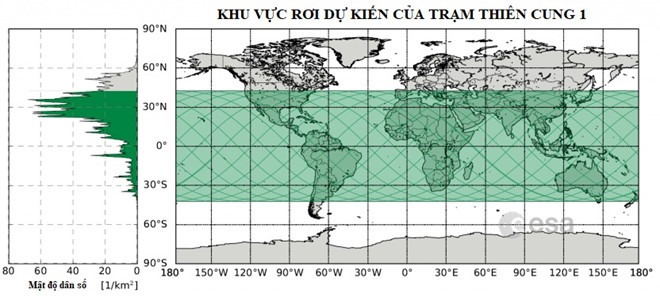The Chinese space station will fall to Earth in the next 24 hours
The European Space Agency has just delayed the time to expect China's Thien Cung 1 space station to fall to Earth due to the impact from the Sun.
In the announcement on March 31, European Space Agency ESA predicted Thien Cung 1 space station will fly into the Earth's atmosphere around 6:00 am on April 2, Vietnam time, which is about 1 second later. date compared to the previous forecast.
According to ESA, the cause of the Thien Cung 1 fall more slowly than forecast is because the solar beams that hit Earth on March 26 did not increase the molecular density of the upper class as scientists look. wait. The high molecular density of the upper layer can pull the space station back to Earth faster.

Fragments of Thien Cung 1 will fall within the range of 43 north latitudes to 43 latitudes south.(Graphics: ESA).
ESA said the fragments of Thien Cung 1 would fall within the range of 43 north latitudes to 43 latitudes south . However, scientists cannot determine exactly where the debris falls.
According to AFP, China's Manned Technical Agency CMSEO stated that people do not need to worry about Thien Cung 1. High temperature and friction will burn or blow away the main structures of the station. Most parts of Thien Cung 1 will disappear when at an altitude of 80km. CMSEO thinks that the remaining debris is likely to fall into the sea.
"The station will not collide with the Earth like what happens in fictional movies. It will break into small pieces and move in the sky like a meteor shower," CMSEO announced.
However, people are advised not to touch the debris of the space station because they may contain hydrazine corrosion, which is very toxic to humans.
Thien Cung 1 is the first space station launched by China on orbit on September 29, 2011. This 8.5-ton space station welcomed two astronauts and successfully connected with three Chinese spacecraft.
Thien Cung 1 had problems and stopped operating in March 2016, making the plan to bring the space station back to Earth in a controlled state that could not be carried out.
- The second Chinese space station may be about to fall to Earth
- In 2019 the Chinese space station will fall to Earth
- China's 8.5-ton space station may crash into Earth in March
- Out of control, the 8.5-ton Thien Cung 1 space station was about to fall to Earth
- China's 8.5-ton space station is about to plunge to Earth
- The stray 8.5-ton space station will create
- The Chinese space station can fall freely to Earth
- The reason why China's 8.5-ton space station doesn't burn out when it falls
- China confirmed Thien Cung 1 station is about to crash into Earth
- The object caught fire, fearing the Chinese space station to fall
- China's Thien Cung 1 Station is about to fall freely
- Places of China's 8.5-ton space station could fall
 Van Allen's belt and evidence that the Apollo 11 mission to the Moon was myth
Van Allen's belt and evidence that the Apollo 11 mission to the Moon was myth The levels of civilization in the universe (Kardashev scale)
The levels of civilization in the universe (Kardashev scale) Today Mars, the sun and the Earth are aligned
Today Mars, the sun and the Earth are aligned The Amazon owner announced a secret plan to build a space base for thousands of people
The Amazon owner announced a secret plan to build a space base for thousands of people